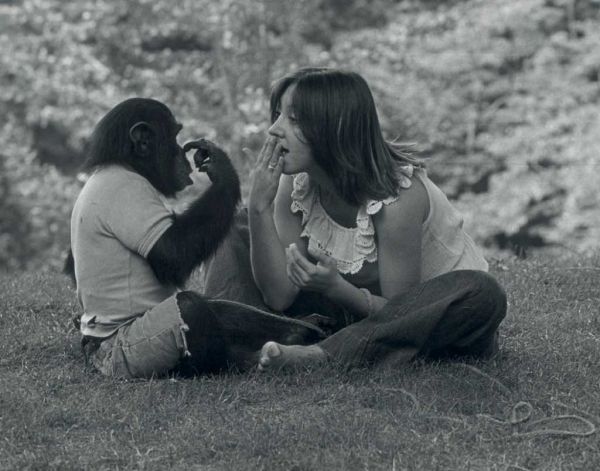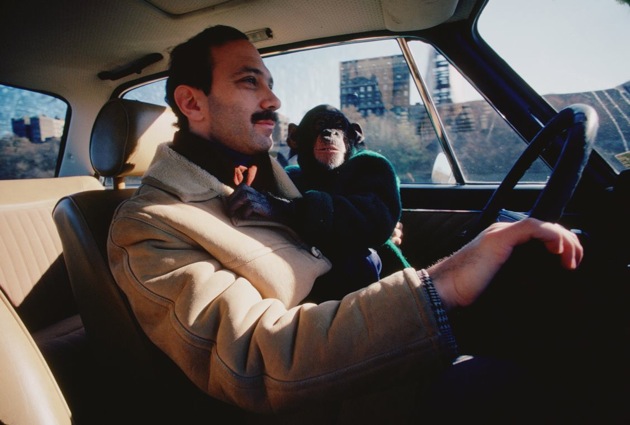“Men have forgotten this truth,” said the fox. “But you must not forget it. You become responsible, forever, for what you have tamed.”
—Antoine de Saint Exupéry, The Little Prince
Perhaps Herbert Terrace, professor of psychology at Columbia University, and director of the experiment that is the subject of Project Nim, a new documentary by James Marsh, never read The Little Prince. The sad story of Terrace’s irresponsible treatment of Nim, the chimp he tamed—or more strictly, whose upbringing in a human family he organized—is the guiding thread of this revealing film, which raises important issues about the distinction between humans and animals, about our attitudes toward animals, and about scientific objectivity (or the lack thereof) in behavioral research.
Nim was born in a primate research center in Norman, Oklahoma. His mother, Caroline, was treated as a breeding machine—all her babies were taken from her for use in experiments. She knew the routine well enough to turn her back to humans as soon as her baby was born, presumably hoping that they would not notice him. But how can a chimpanzee hide her baby, when she lives in a bare cage? Nim was taken from her a few days after his birth, to be used in Terrace’s experiment testing whether sign language could be taught to a chimpanzee. (His full name, Nim Chimpsky, was a play on the name of the linguist Noam Chomsky, who had suggested that only humans have the ability to learn language.)
The film, which draws on Elizabeth Hess’s fine book Nim Chimpsky, overplays the novelty and significance of Terrace’s research. It neglects the real pioneers in this field, the psychologist Keith Hayes and his wife Cathy, who in the 1950s tried to raise a chimpanzee called Vicki as a child, to see if she would learn to speak. The attempt failed, but in 1966 another pair of psychologists, Beatrix and Allen Gardner grasped that the failure may simply have been due to the inadequacies of chimpanzee vocal chords for forming words. They therefore brought up an infant chimpanzee, Washoe, in their own home, using American Sign Language to communicate not only with Washoe, but, when Washoe was present, with each other. Washoe learned many signs, using them singly and in combinations that appeared to be sentences. She even invented some of her own terms, like “candy fruit” for watermelon.
Those who insisted that language is unique to humans, however, simply raised the bar on what counted as language. Some claimed that Washoe had not demonstrated that she really understood the signs she was using. Perhaps she was just imitating her human “parents.” They wanted to see chimpanzees use signs creatively, in novel combinations, or, taking their lead from Chomsky, they insisted that to prove that chimps are using language, it would have to be shown that they implicitly understand and use the syntactical rules that are critical to grasping the difference in meaning between “Mary gave the ball to John” and “John gave the ball to Mary.”
In 1973, Terrace set out to do something similar to what the Gardners did but with, he hoped, a more rigorous focus on whether a chimpanzee really could use language in the same way that humans use it. He arranged for the infant Nim to be adopted by Stephanie LaFarge, a free-spirited former student of his who was bringing up her own family in an apartment on Manhattan’s Upper West Side. In selecting LaFarge, he neglected the crucial element of expertise in sign language. According to LaFarge’s daughter, Jennie, who is interviewed in the film, no one in the house was fluent in sign language. The family did not limit their communications to sign language when Nim was present and La Farge did not even begin to communicate with Nim using signs until he was three months old—an inauspicious start, given that infant chimpanzees develop more rapidly than humans. In other respects, Nim was treated as a new human addition to the family, dressed in human clothes, fed what the family ate, and most importantly, loved and cuddled as a human baby would have been.
Once the teaching began, Nim did pick up some signs. But Terrace wanted more structure in Nim’s learning. He put Laura-Ann Petitto, a student, in charge of Nim’s education. LaFarge and Petitto obviously did not get on. In the film Petitto describes the atmosphere in the LaFarge home as “chaotic” while LaFarge says of Petitto: “She came out of nowhere as a cute little thing from Ramapo.” Terrace organized sessions in which graduate students taught Nim signs, not in his home but in a windowless room at Columbia.
Terrace then decided that Nim would no longer live in the undisciplined atmosphere of the LaFarge household and placed the chimp in Petitto’s care—a decision LaFarge compares with the original taking of Nim from his biological mother. Was this decision influenced by something other than Terrace’s desire to do what was scientifically best for the project? Terrace denies it: “I had strong personal feelings about Laura, but I don’t think that got in any way in the way of our science.”
Advertisement
Nim was moved to a large mansion owned by Columbia University, where he had plenty of space, and where Petitto and two other teachers and carers could also live, while others came as visitors, giving him regular signing lessons. They developed a system for recording Nim’s signing, which was progressing rapidly. Terrace says that at this point the project was “literally humming.” Nim developed a vocabulary of about 120 signs and the project was featured in several magazines and television programs. But Nim was getting stronger, and at times, quite aggressive.
He attacked Petitto several times—in the film she shows the location of one bite that needed 37 stitches, and of another that hit a tendon. That may have made her think of leaving, but as she tells the story to the camera, it seems that a brief romantic involvement with Terrace—and the abrupt way he then ended the relationship—was the most significant factor. “It was the humans I wanted to leave, not the chimp,” she says. She detached herself from the project, and was replaced by Joyce Butler, who had come to the project to write her undergraduate thesis on Nim. Now she became his third surrogate mother. But it wasn’t long before he bit another teacher severely enough to put her into hospital. That, combined with difficulties in raising further funds, led Terrace to decide to end the project after only four years.
Terrace called the group together and told them that they already had ample data that needed analyzing and there was no point in continuing. Nim’s carers and teachers were stunned, but Terrace was telling them of his decision, not seeking their views.
But where should Nim go? From the time he was taken from his mother, he had never known another chimpanzee. He had lived with humans, worn human clothing, and eaten human food. When sorting photos of humans and apes, he placed his own photo among the humans. He had never lived in a cage. Yet Terrace sent him back to the primate research center in Oklahoma. Butler, who went back to Oklahoma with Nim, says “It was just a nasty thing to do… very deceitful.” On camera, she breaks up, crying, as she recalls prying herself free from Nim, who was trying to hold tight to her.
Terrace visited Nim there a year later for a pre-arranged photo shoot. Nim recognized him immediately and engaged him in play and signing, but when Terrace left, Nim just lay there and refused food. Terrace admits that the primate center turned out to be “surprisingly more primitive” than he had remembered and confesses to feeling that what he had done was “not the right thing to do… I was definitely doing something that he would feel was unjust or wrong.” Nevertheless Terrace took no steps to get Nim transferred out of the facility.
Project Nim tells a moving story of the remainder of Nim’s life—he died in a Texas wildlife refuge in 2000—that I will not retell here. The documentary also sheds some light on the way in which Terrace wrote up the results of his research. Before his abrupt decision to close down the project, he had shown enthusiasm for the way in which Nim had learned to sign. Yet in the book that he wrote afterward, he declared it a failure, joining the skeptics in denying that chimpanzees are capable of language. After viewing the videotapes, he concluded that what appeared to be communication was mere imitation.
Some of Nim’s care-givers were startled by Terrace’s sudden about-turn. For Terrace, like some other researchers at the time, the fundamental question was whether a chimpanzee could create a sentence. Nim used signs in combinations, like “Give Nim banana.” If a human child said that, we would all think she had uttered a sentence. As for the idea that Nim’s signing was mere imitation, or a response to a stimulus that elicited the sign, there was ample evidence of Nim initiating conversations. How could that be mere imitation?
Project Nim ended prematurely, at a time when Nim was young, and still learning. It was impossible to tell what he might have achieved. Moreover, Nim had had a checkered upbringing. If he was not learning rapidly enough to satisfy Terrace, might that not have been due to his unsettled home life, and the succession of teachers he had had, rather than to any innate inability to learn language? In the film Terrace himself says “You just can’t count on having outstanding teachers all the time.” But maybe if Terrace himself—who is described by one of Nim’s teachers as an “absentee landlord”—had been more involved in the project, the standard of teaching would have been higher. Was it possible that Terrace had taken such a negative view of Nim’s abilities because dumping a language-using, humanized ape back in a cage with non-language-using chimpanzees would be worse than doing that to an animal without the ability to use language?
Advertisement
Whatever the reasons for Terrace’s verdict regarding Nim’s abilities, it served to reinforce the view that language is a distinguishing mark of what it is to be human. Money for research on teaching language to nonhuman animals dried up, and the whole field was set back for at least a decade. It is now clear, though, that Terrace was wrong to suggest that signing in apes is always some form of imitation. Roger and Deborah Fouts, psychologists who now co-direct the Chimpanzee and Human Communication Institute, at Central Washington University, managed, after a struggle, to take over responsibility for Washoe from the Gardners, and ensure that she did not meet the same fate as Nim. They observed her teaching her companion chimpanzees to sign, and using signs in novel ways, including asking questions about the future—for example, after a snowfall, asking about the “candy tree,” their term for the Christmas tree they get each year.
Perhaps the most rigorous proof that nonhuman animals can understand language comes from the primatologist Sue Savage-Rumbaugh’s research, although her work concerned not chimpanzees but their close relatives, bonobos. Savage-Rumbaugh trained bonobos to use a keyboard to sign, thus eliminating any uncertainty about what was or was not being signed. Kanzi, a bonobo who began to pick up signs without any training, while observing his mother being trained to use the keyboard, clearly understands complex novel sentences. For example, when asked, for the first time, to “make the dog bite the snake,” he takes the toy snake, puts it in the mouth of the toy dog, and closes the dog’s mouth over the snake. He does not put the dog in the snake’s mouth. (In Kanzi’s Primal Language, Savage-Rumbaugh and her co-authors Pär Segerdahl and William Fields suggest that Terrace’s failure to make comparable progress with Nim may have been due to the fact that, in contrast to the way Kanzi picked up language from the environment around him, Nim was supposed to learn it largely in structured sessions, more like the way we teach children a second language.)
Eighteen years ago, Paola Cavalieri and I founded The Great Ape Project, an organization dedicated to the idea of giving great apes the moral status and legal protection that befits their nature. As the work of Jane Goodall, Diane Fossey, Francine Patterson, Birute Galdikas, H. Lyn White Miles, Roger and Deborah Fouts, Sue Savage-Rumbaugh and many other remarkable scientists has shown, chimpanzees, gorillas, bonobos and orangutans are self-aware beings, capable of thought, and with rich and deep emotional lives. Our idea is that the great apes, as our closest relatives, could serve as a bridge over the immense gulf we have dug between ourselves and other animals. Once one group of animals is included within the sphere of beings with rights, we hope that the extension of some basic rights to other sentient animals will be that much easier to make.
Fortunately, the idea that great apes should not be treated as tools for research—as opposed to the kind of relationship developed by Sue Savage-Rumbaugh—has made some progress since the time when Nim was sent back to Oklahoma. Experiments on great apes are now either banned or severely restricted in New Zealand, Australia, Japan, and throughout the European Union.
In the United States, a bipartisan group of members of Congress is supporting legislation to end the use of chimpanzees in invasive research. Project Nim shows that even when research is not invasive, it can have a devastating psychological impact on an animal. What happened to Nim was wrong, and should never happen again.
Project Nim is playing at the Angelika Film Center in New York and in theaters across the country.





